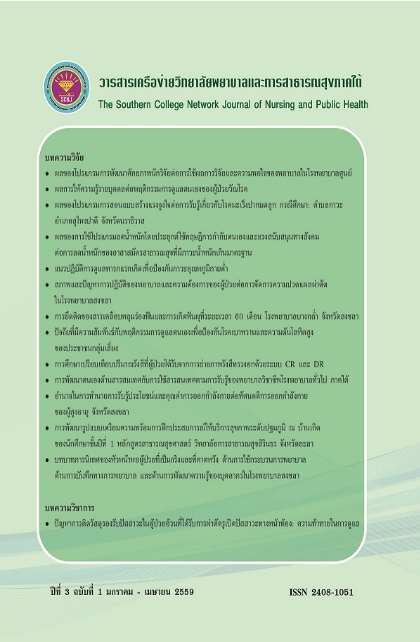ปัญหาการติดวัสดุรองรับปัสสาวะในผู้ป่วยอ้วน ที่ได้รับการผ่าตัดรูเปิดปัสสาวะทางหน้าท้อง: ความท้าทายในการดูแล
คำสำคัญ:
รูเปิดปัสสาวะทางหน้าท้อง, ผู้ป่วยอ้วน, การติดวัสดุรองรับปัสสาวะ, Urostomy, Obese Patients, Urine Pouch Attachmentบทคัดย่อ
ผู้ที่ได้รับการผ่าตัดนำกระเพาะปัสสาวะออก และต้องมีรูเปิดปัสสาวะทางหน้าท้อง เพื่อเป็นทางระบายปัสสาวะ อาจทำให้เกิดปัญหาเนื่องจากไม่สามารถกลั้นน้ำปัสสาวะได้ การดูแลผู้ป่วยกลุ่มนี้ต้องมีการวางแผนการดูแลตั้งแต่ก่อนผ่าตัดด้วยการให้ความรู้ เลือกตำแหน่งรูเปิดปัสสาวะ เลือกวัสดุและวิธีการ มีการวางแผนจำหน่ายที่เหมาะกับแต่ละคน ให้ผู้ป่วยและ/หรือผู้ดูแลได้ฝึกปฏิบัติการดูแลรูเปิดปัสสาวะเพื่อดูแลตนเองก่อนจำหน่าย ผู้ที่มีรูเปิดปัสสาวะเตี้ย และอยู่ในร่องผนังหน้าท้อง หรือต่ำกว่าระดับผิวหนังหน้าท้องอันเนื่องมาจากความอ้วน มักพบว่าวัสดุรองรับปัสสาวะรั่วซึมได้ง่าย ซึ่งการสอนและฝึกการเสริมระดับผิวผนังหน้าท้องด้วยวัสดุยึดติดชนิดครีมข้นร่วมกับแผ่นปกป้องผิวหนัง ที่นำมาปั้นขึ้นรูปจนผิวผนังหน้าท้องเรียบเสมอกัน จะทำให้ติดวัสดุรองรับปัสสาวะได้นานขึ้น สามารถทดแทนการใช้วัสดุพิเศษชนิด Convex ได้ ผู้ป่วยกรณีศึกษาหลังจำหน่ายจากโรงพยาบาลระยะแรก พบว่าวัสดุรองรับปัสสาวะติดได้เพียง 1-2 วัน ใช้เวลาในการติดวัสดุรองรับปัสสาวะแต่ละครั้งนานประมาณ 50 นาที ภายหลังได้รับความช่วยเหลือจากพยาบาลเฉพาะทางใกล้บ้าน และผู้ป่วยมีทักษะมากขึ้น เมื่อเวลาผ่านไปประมาณ 3 เดือน สามารถทำให้วัสดุรองรับปัสสาวะติดได้นานขึ้น 6 -8 วัน ใช้เวลาในการติดวัสดุน้อยลงเหลือประมาณ 10 กว่านาที ความวิตกกังวลลดลง ปรับตัวได้ดีขึ้น และคุณภาพชีวิตดีขึ้น ดังนั้นการดูแลผู้ป่วยกลุ่มนี้จึงควรเน้นการให้ความรู้ การฝึกทักษะก่อนจำหน่าย และการดูแลเป็นระบบที่มีความต่อเนื่องกับสถานพยาบาลเครือข่ายใกล้บ้าน
Problems with Urine Pouch Attachment among Obese Patients with Urostomy: Challenges for Care
After urostomy surgery, the urine is passed out of the body through a “stoma”. The associated care is difficult because the urine output is uncontrolled. The nursing management involves patients receiving preoperative education, a stoma site selection, choosing a suitable pouching system, and ensuring an ostomy plan of postoperative care that is individualized so as, to meet the needs of the patient. This is especially important among obese patients with stomas in deep creasing skin or retracted stomas. Both require teaching, and practice related to the preparation of smooth abdominal surfaces, using proper materials and methods instead of convex ostomy appliances.
Patients must have a minimal level of skill, which has to be specific to their needs, prior to discharge from the hospital due to the ease of a pouch leakage. Enhancing the abdominal surface with adhesive paste and sheet before pouching leads to long-term wear, and the non-necessity of using a convex ostomy appliance.
This case study found a wear time of a few days improved by an average of 6-8 days, and the duration of the attached pouch was approximately reduced from 50 minutes down to about 10 minute within 3 months. This reduced the amount of appliances used due to assistance from enterostomal therapist nurses at the hospital.
In addition, the patient improved his skill, experienced less anxiety, adjusted more easily and increased his quality of life. The care plan for these patients should focus on education and practice before discharge from hospital, and a system that is compatible with the services offered at a hospital nearest their home.
ดาวน์โหลด
เผยแพร่แล้ว
ฉบับ
ประเภทบทความ
สัญญาอนุญาต
1. บทความหรือข้อคิดเห็นใด ๆ ที่ปรากฏในวารสารเครือข่าย วิทยาลัยพยาบาลและการสาธารณสุขภาคใต้ ที่เป็นวรรณกรรมของผู้เขียน บรรณาธิการหรือเครือข่ายวิทยาลัยพยาบาลและวิทยาลัยการสาธารณสุขภาคใต้ ไม่จำเป็นต้องเห็นด้วย
2. บทความที่ได้รับการตีพิมพ์ถือเป็นลิขสิทธิ์ของ วารสารเครือข่ายวิทยาลัยพยาบาลและการสาธารณสุขภาคใต้








